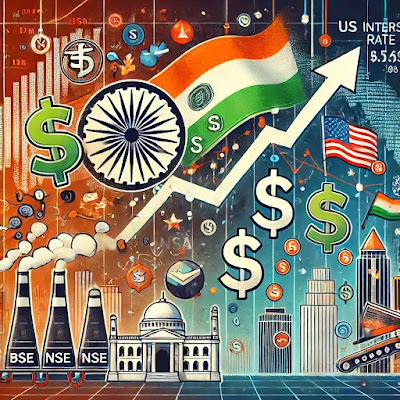How the Recent US Interest Rate Cut Will Impact the Indian Economy
The recent interest rate cut by the US Federal Reserve in September 2024 has caught the attention of global markets. The Fed reduced its interest rates by 25 basis points after a prolonged period of rate hikes aimed at controlling inflation. While the decision was primarily focused on stimulating growth in the US economy, it is bound to have ripple effects across the globe, including India. In this article, we'll explore how the US interest rate cut could affect the Indian economy, financial markets, and everyday lives of Indians.
Understanding the US Interest Rate Cut
To provide some context, the US Federal Reserve had been aggressively raising interest rates since 2022 to curb soaring inflation, which reached 9.1% at its peak. The series of rate hikes gradually brought inflation down to around 3.7% by mid-2024. Now that inflation is nearing the Fed’s 2% target, it has shifted its focus towards boosting economic growth. The recent rate cut of 25 basis points is part of this strategy, making borrowing cheaper in the US to encourage investment and spending.
But how does a change in US interest rates affect the Indian economy? The impact may not be immediate, but it will influence key aspects like foreign investment, currency stability, inflation, and trade.
1. Impact on Foreign Investment
The US interest rate cut is likely to make American bonds and other fixed-income assets less attractive to global investors, including those from India. As returns on US investments decrease, foreign institutional investors (FIIs) might redirect their capital towards emerging markets like India, which typically offer higher returns.
- Increase in Capital Inflows: A lower interest rate in the US may result in an increase in foreign capital inflows into India. FIIs and foreign portfolio investors (FPIs) could find Indian equities and bonds more appealing due to relatively higher interest rates and growth prospects.
- Boost to Indian Stock Market: An influx of foreign investments can lead to increased demand in Indian stock markets, pushing equity prices higher. This would benefit Indian businesses and boost investor sentiment.
2. Effect on the Indian Rupee
The interest rate differential between the US and India plays a significant role in determining exchange rates. A reduction in US interest rates could lead to some weakening of the US dollar, as lower rates tend to decrease demand for dollar-denominated assets.
- Rupee Appreciation: If the dollar weakens, the Indian rupee could appreciate against it. This would make imports cheaper for India, particularly crude oil, which is a major component of India’s import basket. Cheaper imports could help reduce inflationary pressures in India.
- Export Concerns: On the flip side, a stronger rupee could make Indian exports less competitive in global markets, as Indian goods and services become more expensive for international buyers. Key sectors like IT services, textiles, and pharmaceuticals may feel the pinch of a stronger rupee.
3. Impact on Inflation in India
The US interest rate cut could indirectly influence inflation in India. Lower borrowing costs in the US may encourage global economic activity, leading to a potential rise in demand for commodities like oil and metals. Since India imports a significant portion of its crude oil, a rise in global oil prices could result in higher inflation domestically.
- Oil Prices and Inflation: Historically, any fluctuations in oil prices have had a direct impact on inflation in India, as oil is essential for transportation, manufacturing, and other industries. If global oil prices rise due to increased demand driven by economic activity in the US, inflation could rise in India.
- Monetary Policy Response: To combat inflation, the Reserve Bank of India (RBI) may consider adjusting its monetary policy. If inflationary pressures increase, the RBI could delay potential interest rate cuts or even raise rates to keep inflation in check.
4. Impact on Indian Businesses
Indian companies that have business ties with the US, particularly in sectors like IT services, pharmaceuticals, and manufacturing, will experience mixed impacts from the US rate cut.
- Export-Oriented Sectors: For companies in export-oriented industries, the interest rate cut in the US may lead to more demand for Indian goods and services, particularly if the US economy strengthens as a result. However, as mentioned earlier, a stronger rupee could offset this by making Indian exports more expensive.
- Cheaper Borrowing for Expansion: For Indian companies with international exposure, a US rate cut could mean cheaper access to financing in global markets. This can encourage Indian businesses to raise funds through international markets for expansion and capital investments.
5. Global Trade and Commodities
The US interest rate cut may have broader implications for global trade, including India’s position in the global supply chain.
- Boost to Global Trade: If the rate cut helps stimulate growth in the US economy, it could lead to a pickup in global trade activity. India, being a major exporter of goods like textiles, IT services, and pharmaceuticals, stands to benefit from a more active global trade environment.
- Commodities Prices: Increased economic activity in the US could also drive up demand for commodities like oil, metals, and agricultural products. While this would benefit commodity exporters, it could lead to higher import bills for India, particularly in the case of crude oil and other essential imports.
6. Indian Financial Markets
The impact of the US rate cut on Indian financial markets could be significant, particularly in terms of liquidity and investment patterns.
- Stock Market Boost: Indian equities may see increased foreign investor interest due to lower yields in the US. Sectors like technology, finance, and manufacturing could see stock price appreciation as a result of this increased liquidity.
- Bond Market: On the other hand, India’s bond market might also benefit as FIIs seek higher yields compared to the low returns offered in the US. This can bring down yields on Indian government securities, reducing borrowing costs for the government and potentially freeing up resources for development projects.
Conclusion
The recent US interest rate cut will have a multifaceted impact on the Indian economy. While the inflow of foreign capital, potential rupee appreciation, and opportunities for export-oriented businesses could provide short-term benefits, challenges remain in managing inflation and maintaining export competitiveness. The Reserve Bank of India and Indian policymakers will need to stay vigilant to ensure that India navigates these global shifts smoothly.
As the US seeks to stimulate its own economy, India, as a fast-growing emerging market, must carefully balance its own monetary and fiscal policies to optimize the benefits and mitigate the risks posed by changes in global interest rates.
FAQs
Q: Will the US interest rate cut lead to a stronger rupee?
A: Yes, the US rate cut could lead to a weaker dollar, which may result in the rupee appreciating against the dollar.
Q: How does a US interest rate cut affect Indian stock markets?
A: A US rate cut often results in foreign investors seeking higher returns in emerging markets like India, potentially boosting Indian stock markets.
Q: Will inflation rise in India due to the US rate cut?
A: If global commodity prices rise, particularly crude oil, it could increase inflationary pressures in India.








